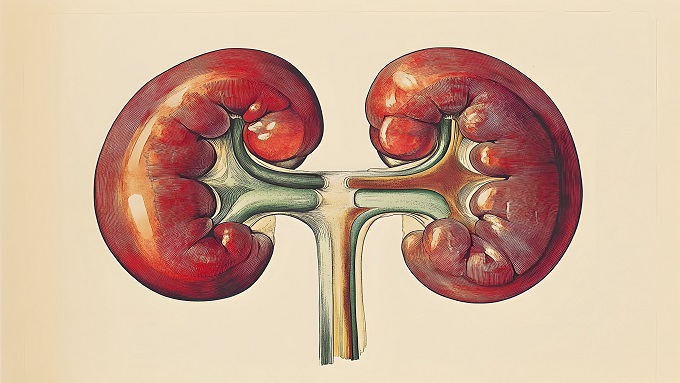The Effect of Intravenous Glutamine Administration in Lowering AIF Expression in Renal Tubular Cells

Downloads
Highlights
- Glutamine, an amino acid, can help mitigate the side effects of cisplatin by boosting glutathione (GSH) levels, an antioxidant that counteracts oxidative stress.
- By reducing AIF protein expression and apoptosis, glutamine may protect kidney cells from cisplatin toxicity, potentially improving the safety of chemotherapy.
Background: Cisplatin, a widely used chemotherapy that is effective for many forms of cancer, has nephrotoxic qualities that can reduce renal function. Due to its side effects, the usage of cisplatin is limited by its dose. Glutamine, an amino acid, possesses properties that can counteract the nephrotoxicity of cisplatin. Objective: This study aimed to analyze the effect of intravenous glutamine administration on the decrease of AIF expression and apoptosis in intraglomerular mesangial cells of cisplatin-exposed rats. Material and Method: Samples (n) consisting of 30 rats were divided into 3 groups, with each group containing 10 rats. Group P0 received no treatment, group P1 received an injection of cisplatin on the 7th day, and group P2 received glutamine on the 1st–7th day and an injection of cisplatin on the 7th day. After 72 h, the tissue samples were immunohistochemically processed and then observed under a light microscope with 400x magnification. AIF expression and apoptosis were measured in the Allred/H score. Result: AIF expression results were: P0 = 4,35(2,2-5,4); P1 = 5,9(4,8-6,3); P2 = 5,25(2,4-5,8). The AIF expression of P2 was found to be significantly lower (p = 0.008) than P1. Apoptosis results were: P0 = 5,2(4,7-5,5); P1 = 6,4(6,1-7,1); P2 = 5,7(4,8-5,9). The apoptosis level of P2 was found to be significantly lower (p = <0.0001) than P1. Strong correlations between the decrease in AIF expression and the apoptosis level were found (p = <0.0001). Conclusion: Glutamine contributes to the decreased AIF expression and apoptosis in intraglomerular mesangial cells of cisplatin-exposed rats.
Asantewaa, G., Harris, I. S. 2021. Glutathione and its precursors in cancer. Current Opinion in Biotechnology, 68: 292–299. doi: 10.1016/j.copbio.2021.03.001.
Bano, D., Prehn, J. H. M. 2018. Apoptosis-inducing factor (AIF) in physiology and disease: The tale of a repented natural born killer. eBioMedicine, 30: 29–37. doi: 10.1016/j.ebiom.2018.03.016.
Basu, A., Krishnamurthy, S. 2010. Cellular responses to Cisplatin-induced DNA damage. Journal of nucleic acids, 2010. doi: 10.4061/2010/201367.
Brown, J. S., Amend, S. R., Austin, R. H., et al. 2023. Updating the definition of cancer. Molecular Cancer Research, 21(11): 1142–1147. doi: 10.1158/1541-7786.MCR-23-0411.
Cruzat, V., Rogero, M. M., Keane, K. N., et al. 2018. Glutamine: Metabolism and immune function, aupplementation and clinical translation. Nutrients, 10(11): 1564. doi: 10.3390/nu10111564.
Dasari, S., Tchounwou, P. B. 2014. Cisplatin in cancer therapy: Molecular mechanisms of action. European Journal of Pharmacology, 740: 364–378. doi: 10.1016/j.ejphar.2014.07.025.
Fakhrinnisa, T. A., Susilo, I., Mustika, A., et al. 2021. Effect of intravenous glutamine on caspase-12 expression in the apoptosis of the glomerular epithelial cells of male rats exposed to cisplatin. Asian Pacific Journal of Cancer Prevention: APJCP, 22(2): 457–462. doi: 10.31557/APJCP.2021.22.2.457.
Gould, R. L., Pazdro, R. 2019. Impact of supplementary amino acids, micronutrients, and overall diet on glutathione homeostasis. Nutrients, 11(5): 1056. doi: 10.3390/nu11051056.
Ho, H.J., Shirakawa, H. 2022. Oxidative stress and mitochondrial dysfunction in chronic kidney disease. Cells, 12(1). doi: 10.3390/cells12010088.
IBM Corp. 2019. IBM SPSS statistics for Windows, version 26.0. Armonk, NY: IBM Corp. Available at: https://www.ibm.com/id-id/products/spss-statistics.
Jeong, J.J., Park, N., Kwon, Y. J., et al. 2014. Role of annexin A5 in cisplatin-induced toxicity in renal cells. Journal of Biological Chemistry, 289(4): 2469–2481. doi: 10.1074/jbc.M113.450163.
Kim, J. Y., Han, Y., Lee, J. E., et al. 2018. The 70-kDa heat shock protein (Hsp70) as a therapeutic target for stroke. Expert Opinion on Therapeutic Targets, 22(3): 191–199. doi: 10.1080/14728222.2018.1439477.
Kwon, D. H., Cha, H. J., Lee, H., et al. 2019. Protective effect of glutathione against oxidative stress-induced cytotoxicity in RAW 264.7 macrophages through activating the nuclear factor erythroid 2-related factor-2/heme oxygenase-1 pathway. Antioxidants, 8(4): 82. doi: 10.3390/antiox8040082.
Lumintang, M.,Joewarini, E., Zakaria, S., et al. 2020. Effect of glutamine before gets cisplatin on AIF and Bcl-2 in the evidence of apoptosis cell tubulus proximal in rats kidney of Rattus norvegicus strain wistar. Indian Journal of Forensic Medicine & Toxicology, 14(2): 1742–1746. doi: 10.37506/ijfmt.v14i2.3188.
Luque-Ceballos, J. C., Rodríguez-Zamora, P., López-Olivos, J. C., et al. 2023. Revisiting the scavenging activity of glutathione: Free radicals diversity and reaction mechanisms. Computational and Theoretical Chemistry, 1227: 114227. doi: 10.1016/j.comptc.2023.114227.
Mazières, J., Brugger, W., Cappuzzo, F., et al. 2013. Evaluation of EGFR protein expression by immunohistochemistry using H-score and the magnification rule: Re-analysis of the SATURN study. Lung Cancer, 82(2): 231–237. doi: 10.1016/j.lungcan.2013.07.016.
Microsoft Corporation. 2018. Microsoft Excel, Available at: https://office.microsoft.com/excel
Ministry of Health of Republic Indonesia. 2019. Cancer in Indonesia is ranked 8th in Southeast Asia and 23rd in Asia, Kemenkes. Available at: https://www.kkpmerauke.com/berita-31-penyakit-kanker-di-indonesia-berada-pada-urutan-8-di-asia-tenggara-dan-urutan-23-di-asia.html.
Negara, K. S., Suwiyoga, K., Sudewi, R., et al. 2020. The role of caspase-dependent and caspase-independent pathways of apoptosis in the premature rupture of the membranes: A case-control study. International Journal of Reproductive BioMedicine (IJRM). doi: 10.18502/ijrm.v13i6.7285.
Oh, G. S., Kim, H. J., Shen, A., et al. 2014. Cisplatin-induced kidney dysfunction and perspectives on improving treatment strategies. Electrolyte & blood pressure : E & BP, 12(2): 55–65. doi: 10.5049/EBP.2014.12.2.55.
Priante, G., Gianesello, L., Ceol, M., et al. 2019. Cell death in the kidney. International Journal of Molecular Sciences, 20(14): 3598. doi: 10.3390/ijms20143598.
Rabelink, T. J., Heerspink, H. J. L., de Zeeuw, D. 2015. The pathophysiology of proteinuria. in Chronic Renal Disease. Elsevier: 92–105. doi: 10.1016/B978-0-12-411602-3.00009-3.
Redza-Dutordoir, M., Averill-Bates, D. A. 2016. Activation of apoptosis signalling pathways by reactive oxygen species. Biochimica et Biophysica Acta (BBA) - Molecular Cell Research, 1863(12): 2977–2992. doi: 10.1016/j.bbamcr.2016.09.012.
Sabirzhanov, B., Stoica, B. A., Hanscom, M., et al. 2012. Over‐expression of HSP70 attenuates caspase‐dependent and caspase‐independent pathways and inhibits neuronal apoptosis. Journal of Neurochemistry, 123(4): 542–554. doi: 10.1111/j.1471-4159.2012.07927.x.
Stankiewicz, A. R. et al. (2005) ‘Hsp70 inhibits heat-induced apoptosis upstream of mitochondria by preventing bax translocation’, Journal of Biological Chemistry, 280(46), pp. 38729–38739. doi: 10.1074/jbc.M509497200.
Suhaili, S. H., Lachapelle, G., Foo, C. P. Z., et al. 2017. Mitochondrial outer membrane permeabilization: A focus on the role of mitochondrial membrane structural organization. Biophysical Reviews, 9(4): 443–457. doi: 10.1007/s12551-017-0308-0.
Tsuruya, K., Ninomiya, T., Tokumoto, M., et al. 2003. Direct involvement of the receptor-mediated apoptotic pathways in cisplatin-induced renal tubular cell death. Kidney International, 63(1): 72–82. doi: 10.1046/j.1523-1755.2003.00709.x.
Vasaikar, S. V., Ghosh, S., Narain, P., et al. 2015. HSP70 mediates survival in apoptotic cells—Boolean network prediction and experimental validation. Frontiers in Cellular Neuroscience, 9. doi: 10.3389/fncel.2015.00319.
Zhang, Y., Bishop, P. A. 2020. Can L‐glutamine augmented heat shock protein 70 expression prevent exercise‐induced exertional heat stroke and sudden cardiac death?. CNS Neuroscience & Therapeutics, 26(1): 148–150. doi: 10.1111/cns.13217.
Zong, L., Liang, Z. 2023. Apoptosis-inducing factor: A mitochondrial protein associated with metabolic diseases—a narrative review. Cardiovascular Diagnosis and Therapy, 12(3): 609–622. doi: 10.21037/cdt-23-123.
Copyright (c) 2025 Raihan Akbar Muhammad, Imam Susilo, Eko Budi Koendhori, Bambang Purwanto

This work is licensed under a Creative Commons Attribution 4.0 International License.
1. The journal allows the author(s) to hold the copyright of the article without restrictions.
2. The journal allows the author(s) to retain publishing rights without restrictions.
3. The legal formal aspect of journal publication accessibility refers to Creative Commons Attribution 4.0 International License (CC-BY).






























